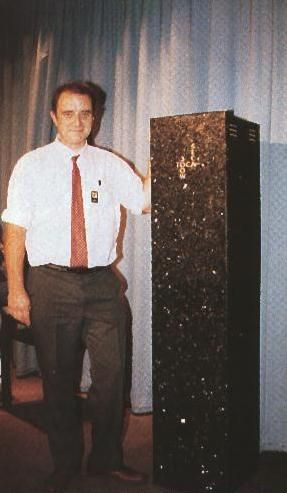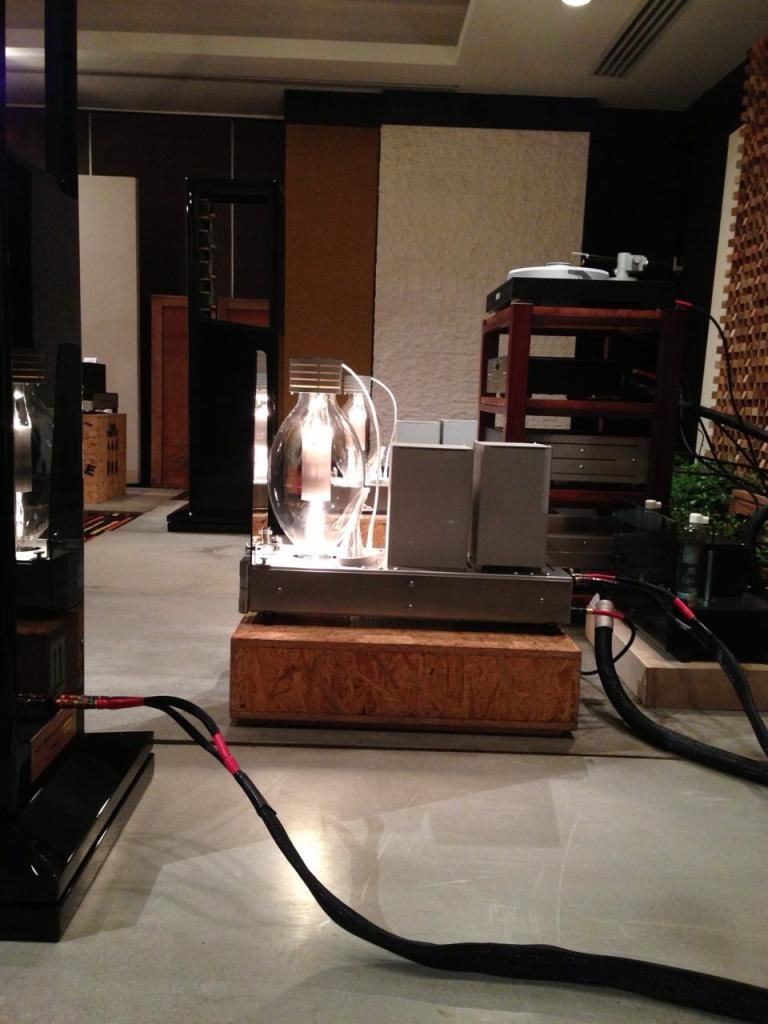Deleted
Deleted Member
Posts: 0
|
Post by Deleted on Jun 15, 2014 20:59:21 GMT
What are your thought.
Has you may gather I prefer SECA designs and normally FET output stages. This is not to all tastes.
So what are your thoughts please.
|
|
|
|
Post by MartinT on Jun 15, 2014 21:25:26 GMT
Presumably SECA stands for Single-Ended Class A?
I think it's a very personal choice, Colin, and one that maybe everyone will answer differently. I have only heard valve SE designs and, to be honest, they are not for me. What they win in delicacy and fine detail they lose in structure, fundamentals and dynamics (except micro-dynamics). A SECA design into a high efficiency horn like the Horning Agathon is very alluring, but I don't think I could live with it as my single chosen design to run my system. However, I have never to my knowledge heard a SECA transistor design.
So, for me, push-pull MOSFET gives the best overall combination of welly, low distortion, good all-round performance and no thermal runaway.
|
|
Deleted
Deleted Member
Posts: 0
|
Post by Deleted on Jun 15, 2014 21:48:14 GMT
The shame is that Tube/Valve SECA designs are in the norm transformer coupled and this will lose top end and damping. The old designs by JLH and Noel Keywood and in the Mullard design books are all choke and or capacitor coupled, this does limit there damping factors and BW. With the latest beasts i.e. TOCA a large constant current load is used but the heat is high. The damping factor then can be increased to over 1000 as to 20-50 this sounds much better. The output is 5 FET's in parallel performing a Source follow output stage and the driver stage is only a single transistor with a high BW and high current capability. The control of the DC offset is another matter but no capacitor in the output or input path. 10Hz - 100KHz is now easily met. I to like Push-Pull FET designs but some can and do sound to harsh, one that come to mind was the Dr Thomas design and The Bryston. All of them sounded like the raw unrefined Maplin/Hitachi apps note design. Now the 300W MONO TOCA were in a class of there own, OK you did need you own substation but they did drive horrid loads, but at 1800W consumption each you would be broke after a good party. And big at the Penta Show people thought they were speakers at a 180KG each.  |
|
|
|
Post by MartinT on Jun 15, 2014 22:10:48 GMT
All of them sounded like the raw unrefined Maplin/Hitachi apps note design. I built a full amplifier out of that Hitachi circuit design, with over-the-top power supply. It could push out a lot of power, but sounded cold, clinical and dynamically flat. Definitely a dead end for my system development for a while. |
|
Deleted
Deleted Member
Posts: 0
|
Post by Deleted on Jun 16, 2014 3:25:30 GMT
Here from the 2014 Thailand Audio Show are some large valve Single Ended Class A, note the size of the transformer, with the huge DC current to bias the valve into class and not saturate the magnetic core and drive it of zero you need lots of material. But there is another way which I will discuss later and outperform convention.   |
|
|
|
Post by MikeMusic on Jun 16, 2014 20:42:33 GMT
That is quite a statement !
How did it sound ?
|
|
|
|
Post by MartinT on Jun 16, 2014 21:26:49 GMT
I wouldn't want to mess with the anode caps on those  |
|
|
|
Post by ChrisB on Jun 16, 2014 21:59:18 GMT
Presumably they're tropical fish that he keeps in those bowls?
|
|
Deleted
Deleted Member
Posts: 0
|
Post by Deleted on Jun 17, 2014 5:20:38 GMT
I wouldn't want to mess with the anode caps on those  Martin, It would just tickle once. And with the music playing the dance could be called "SECA Night" so you would have started a new trend. Cool Dude.  |
|
Deleted
Deleted Member
Posts: 0
|
Post by Deleted on Jun 17, 2014 5:23:06 GMT
That is quite a statement ! How did it sound ? Like most Thai and Chinese once it settles you are still hungry. Not a clue Mike I am not allowed to travel due to insurance issues and health. |
|
|
|
Post by MikeMusic on Jun 25, 2014 8:00:14 GMT
Ha !
Sorry to hear about the health issue
|
|
Deleted
Deleted Member
Posts: 0
|
Post by Deleted on Jun 27, 2014 12:33:35 GMT
What are your thought. Has you may gather I prefer SECA designs and normally FET output stages. This is not to all tastes. So what are your thoughts please. After quite a bit of messing about over the years I've come to the firm opinion that there are good examples of all paradigms. After listening to enough examples of different types the hardest stallwarts have been knwon to alter their opinion, IME. One reson I am known for getting the soap box out is for this thing called synergy. I know from experience that if you match the right amp with the right speaker with regard to damping then startling things appear. I have deliberately designed speakers with a highly damped alignment to match single ended valves(with no damping factor as such) and got some astounding results. Conversely, playing the same speakers with highly damped SS amps has sounded truly dull. bottom line for me is it's good if you like it, irrespective of the type or method. |
|
|
|
Post by farscape on Jun 27, 2014 16:02:49 GMT
Not all Single ended amps suffer the same failings, you cannot pigeon hole one design over the other, its down to the designer, the design, and how it is implemented.
|
|
Deleted
Deleted Member
Posts: 0
|
Post by Deleted on Jun 28, 2014 12:37:11 GMT
Some early SS design had choke with capacitor coupled outputs, but I use high constant current designs with low gain stages, but wide BW.
And over the top PSU because I like them, and the tend to be much more reliable.
It just a shame that big large heatsinks are so costly and heavy.
|
|
Deleted
Deleted Member
Posts: 0
|
Post by Deleted on Jun 28, 2014 12:53:19 GMT
I've got a couple of SE valves, a couple of PP valves, a couple of PP solid state and a single ended solid state, and a couple of single ended SIT under development on the work bench. I know which one I prefer at any particular time but I'm pretty certain not one of them is any better than any of the others, to my ears. Any one of them will sound pretty bad to me if connected to an unsympathetic pair of speakers. My current passion is for stiff, choke input power supplies, and as far as the valves are concerned I'm neurotic about good dc filament supplies, preferably regulated. These areas even I can detect improvement when changes happen. edit: Sadly(or not) I think I've got to the stage where I'm very complacent about amps. Anybody can play me a new amp but I don't think there's anyway they could convince me it's any better than what I've already got. It might be different, but better?  ...nowadays I'm much happier talking about the music. Maybe it's age creeping up. |
|
|
|
Post by MikeMusic on Jun 28, 2014 14:41:54 GMT
Some early SS design had choke with capacitor coupled outputs, but I use high constant current designs with low gain stages, but wide BW. And over the top PSU because I like them, and the tend to be much more reliable. It just a shame that big large heatsinks are so costly and heavy. Thicko question alert : Aren't heatsinks just lumps of metal or did I miss summat ? |
|
Deleted
Deleted Member
Posts: 0
|
Post by Deleted on Jun 28, 2014 15:10:08 GMT
Thicko question alert : Aren't heatsinks just lumps of metal or did I miss summat ? yes and no, they have heat coefficients which determine their temperature rise against watts dissipated. The more suface area of heat sink, the better the heat dissipation. Usually the more fins, and hence the more air contact, the better the dissipation. A lump of metal is not the most efficient heatsink. As an example I have a firstwatt F4 which is marginal on a figure of 0.26 degrees/watt. 0.26 is very very efficient and requires lots of large fins and 2 heatsinks 12" x 6" with 40mm fins barely gets rid of the heat....50 degrees above ambient.  |
|
|
|
Post by MartinT on Jun 28, 2014 17:39:51 GMT
That's 192W of dissipation! Your room must get warm. So what is the power output at what efficiency?
|
|
Deleted
Deleted Member
Posts: 0
|
Post by Deleted on Jun 28, 2014 17:45:26 GMT
That's a lot of heat dissipation area I knew Nelson's designs were somewhat what warm to touch lol
Interestingly the CE directives have a maximum outside temperature that the casework is allowed reach before it fails the test (and the CE approval), I could name at least five amplifiers that would not comply with this directive, not all are Chinese!
I have listened to Colin's recent little TQ class 'a' unit very nice with the right speakers it certainly does sing.
|
|
Deleted
Deleted Member
Posts: 0
|
Post by Deleted on Jun 28, 2014 18:15:11 GMT
Hi Martin
that particular amp(F4) is a buffer, it has a gain of 0.9. It can output upto 25w with the right pre but in the configuration I use it does about 3watts flat out when driven by a squeezebox. Full class A it always burns 190watts. It's very easy to drop the bias a bit, but it just doesn't sound the same.
all my mosfet/jfet/sits use the same heatsinks which I get from Conrads in Australia.
Hi Tony
I don't think Nelson worries too much about CE regs, but I may be wrong. It's no biggy to put bigger sinks if necessary. I have an F2 which uses the same sinks but at 5w output it doesn't produce anywhere near as much heat as the F4. Nelson uses a different shape sink on his production models but I can't say what coefficient they would be. There is a bit of a yardstick in the firstwatt fan following, if you can leave your hand on the sink for 5 seconds then it's not too hot.
edit: guys I might have exaggerated slightly, it's nearly 10 years since I did the F2/F4. I think the total temp would be 50 degrees so thats 30 above ambient. I can dig out my notes and tell you exactly what each mosfet dissipates if you really need to know.
|
|